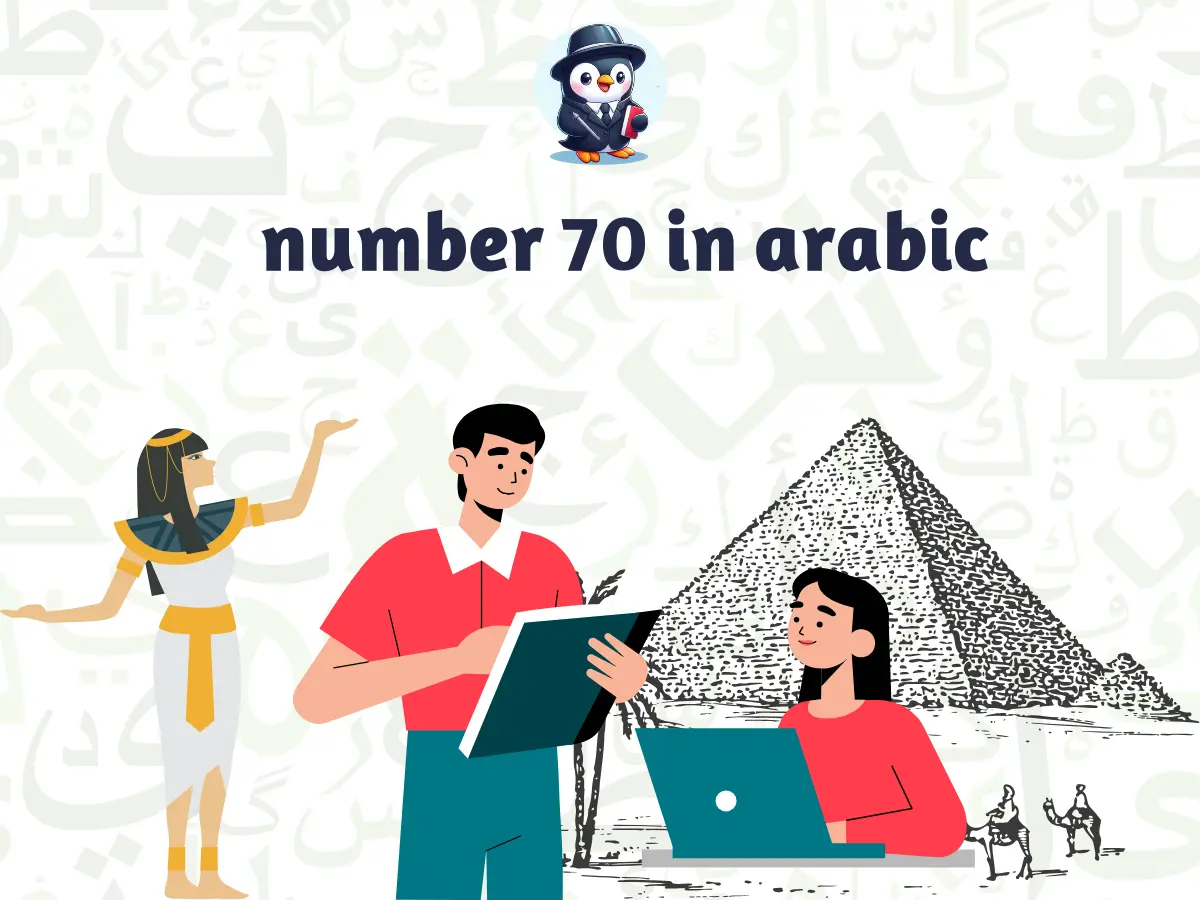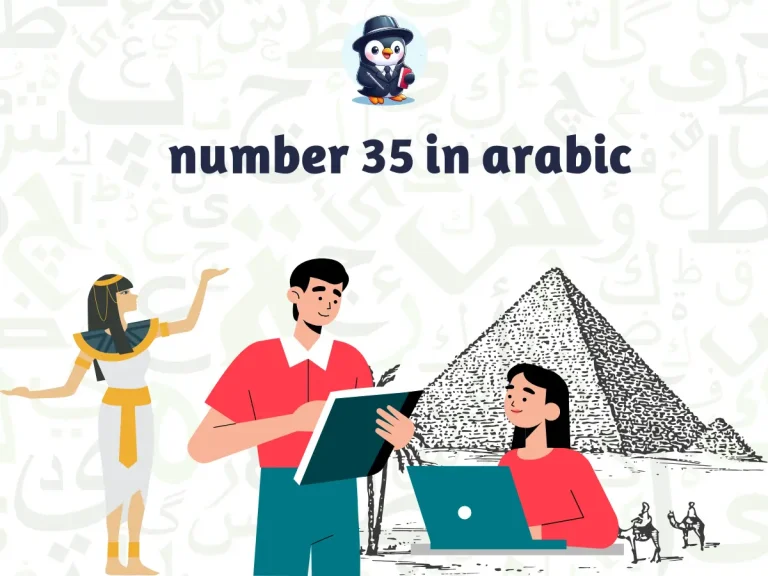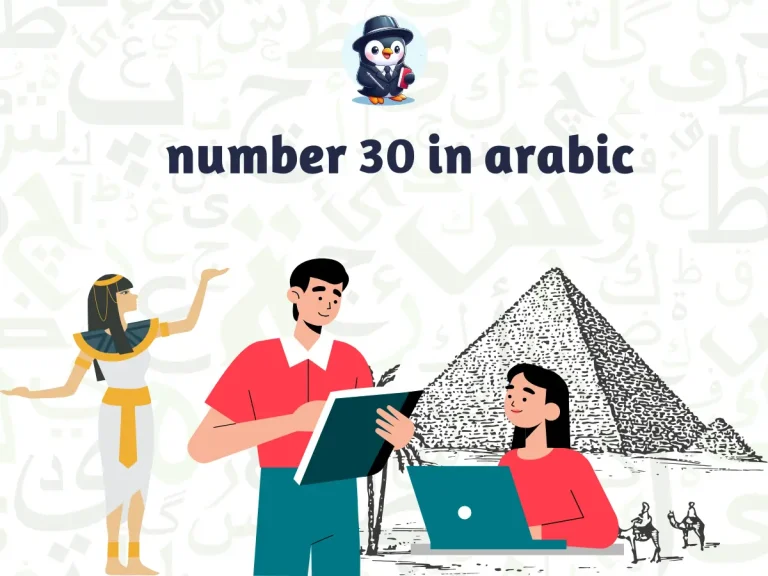number 70 in arabic pronunciation & writing
The number 70 in arabic, “Sabʿoon” (سبعون) in Arabic, holds a unique position within the language.
It transcends its numerical value, serving as a crucial tool for everyday use and a symbol with potential deeper meaning.
To learn more about the rest of the numbers from 1 to 100, you can visit this link: Arabic numbers 1 to 100
Here’s a deeper look at the importance and diverse uses of “Sabʿoon”:
number 70 in arabic: Essential for Daily Transactions
Arabic expresses quantities exceeding the base-ten system through numerals. Mastering “Sabʿoon” empowers you to confidently discuss prices and larger measurements with precision.
- Imagine confidently negotiating a rug’s price at a market (“yaghoolu thamanoon, walakin naqbal bi-sabʿoon” – he says eighty, but we accept seventy)
- or ordering ingredients for a recipe that requires a specific amount (“urīdu sabʿoon graman min السكر (sukkar)” – I want seventy grams of sugar).
number 70 in arabic: A Number Steeped in Symbolism
Unlike previous numbers, “Sabʿoon” carries significant symbolic weight in Islamic culture and Arabic expressions. Here’s why:
Religious Significance: The number seventy appears frequently in Islamic texts, often associated with divine decrees or significant events.
- For example, the Quran mentions the seventy disciples sent by Moses (peace be upon him). This association lends “Sabʿoon” a sense of importance and completion.
Proverbs and Sayings: Arabic proverbs and sayings often utilize “Sabʿoon” metaphorically.
- For example, “من جار على سبعين جار عليه” (man jaara ʿala sabʿeen jaara ʿalayh)
translates to “whoever wrongs seventy will be wronged,” implying a significant transgression.
number 70 in arabic: Unlocking Dates and History
Dates on historical buildings and documents are often written in numerals. Knowing how to read “Sabʿoon” allows you to decipher these references.
- An inscription mentioning “اكتمل ترميم المكتبة سنة سبعين بعد المئتين والألف (iktamal tarmeem almaktabah sanat sabʿeen baʿda al-miʾatayn wa al-alf)”
translates to “the restoration of the library was completed in the year seventy after two hundred and one thousand.”
A Stepping Stone to Larger Numbers: Understanding “Sabʿoon” lays the foundation for expressing a wider range of numbers with ease.
- It becomes a building block for numbers like one hundred forty (“miʾah wa arbaʿoon” – مئة وأربعون) and even larger quantities.
A Note on Dialectal Variations: While “Sabʿoon” serves as the standard form in Modern Standard Arabic, spoken dialects might introduce slight variations in pronunciation,
particularly those with a Bedouin background, pronouncing it with a softer “q” sound at the beginning. However, the core meaning remains the same.
By appreciating the multifaceted nature of “Sabʿoon,” you gain a deeper understanding of Arabic communication.
You can navigate everyday situations, historical references, and cultural nuances.
“Sabʿoon” serves as a bridge, connecting the practicalities of the present with the rich symbolism and historical significance woven into the Arabic language.
Seventy: A Crossroads of Symbolism and Utility Across Civilizations
The number 70 in arabic, “Sabʿoon” (سبعون) in Arabic, occupies a fascinating space.
It transcends its numerical value, serving not only as a tool for everyday communication but also as a symbol with deep roots in both ancient cultures and Islamic tradition.
Here, we explore the importance and distinction of “Sabʿoon,” delving into its historical significance beyond the Arabic language.
Importance and Distinction in Arabic: 70 in arabic
Essential for Daily Use: Arabic numerals extend beyond the base-ten system. Mastering “Sabʿoon” empowers you to confidently discuss specific measurements and prices.
A Threshold of Precision: Similar to “Khamsoun” (fifty) and “Sittuun” (sixty), “Sabʿoon” marks a shift.
Unlike previous numbers formed by combining smaller ones, it’s a distinct word, highlighting its importance for larger quantities.
Symbolic Significance: Unlike prior numbers, “Sabʿoon” carries a unique symbolic weight in Arabic culture, as we’ll explore further.
Distinguishing Seventy: 70 in arabic
Structure and Sound: “Sabʿoon” (sev-en-ty) differs from previous numbers by being a single word with a distinct sound, emphasizing its importance in the number system.
The “ʿAin” Sound (Optional): While not present in all dialects, some pronunciations might utilize the “ʿain” (ع) sound, a guttural sound produced from the back of the throat.
The number 70 in arabic in Ancient Cultures
The historical significance of “Sabʿoon” extends beyond Arabic:
Mesopotamian Influences: The sexagesimal system (base-60) used in ancient Mesopotamia might offer a potential connection.
Seventy could have been viewed as a specific unit within that system, although a direct link is not fully established.
Biblical References: The number seventy appears in the Hebrew Bible, associated with significant periods or events.
For example, the Israelites spend seventy years wandering in the wilderness. This suggests a potential connection to the symbolic weight of “Sabʿoon” in later cultures.
The Symbolism of Seventy in Arabic Culture
The most significant distinction of “Sabʿoon” lies in its symbolic meaning within Islamic tradition:
Religious Significance: The number seventy appears frequently in Islamic texts, often associated with divine decrees, trials, or blessings.
- For example, the Quran mentions the seventy angels who descend nightly with mercy (70:5). This association lends “Sabʿoon” a sense of importance, completion, or divine intervention.
Proverbs and Sayings: Arabic proverbs and sayings often utilize “Sabʿoon” metaphorically.
These proverbs might reference waiting for “seventy years” to imply a very long time or emphasize the concept of enduring hardship for “seventy mornings.”
Variations Across Dialects: number 70 in arabic
While “Sabʿoon” serves as the standard form in Modern Standard Arabic, spoken dialects might introduce slight variations in pronunciation,
particularly those with a Bedouin background, pronouncing it with a softer “q” sound at the beginning. However, the core meaning remains the same.
By understanding both the practical importance and symbolic weight of “Sabʿoon” in Arabic, and its potential connection to ancient cultures, you gain a well-rounded perspective on this number.
It empowers you to navigate everyday situations with confidence while appreciating the cultural and historical tapestry woven into the language.
Writing and Pronouncing number 70 in arabic
The number 70 in arabic, “Sabʿoon” (سبعون), might seem like a complex progression from previous numbers in Arabic.
However, understanding its pronunciation and structure empowers you to navigate the language with confidence.
Here’s a comprehensive guide on writing and pronouncing this crucial number:
Writing with Accuracy: number 70 in arabic
- One Word: Unlike previous numbers that were phrases, “Sabʿoon” is a single word.
- Here’s how to write “Sabʿoon” from right to left: سبعون
| Pronunciation | Arabic | English |
|---|---|---|
| sabʿoon | سبعون | seventy |
| yaḥtāj al-iṣlaḥ sabʿoon yawman | يحتاج الإصلاح سبعين يوما | The repairs will take seventy days. |
Pronunciation for Clarity: number 70 in arabic
Breaking it Down: “Sabʿoon” is pronounced approximately as sab-oon (with a short “oo” sound).
- The “ʿAin” Sound (Optional): Some pronunciations, particularly in dialects with roots in Bedouin Arabic, might include the “ʿain” (ع) sound at the beginning. This sound is a guttural sound produced from the back of the throat.
However, most dialects and Modern Standard Arabic omit this sound.
Examples in Action: number 70 in arabic
1- وجدت سبعين ريالا في جيبي
wajadtu sabʿoon riyalan fi jaybi.
I found seventy riyals in my pocket.
2- كم يبعد الشاطئ؟ سبعون كيلومترا
kam yabʿadu al-shaţiʾ? sabʿoon kilometra.
How far is the beach? Seventy kilometers.
Bonus Tip: While less common, you might encounter pronunciations with a softer “q” sound at the beginning in some dialects, particularly those with a Bedouin background. This retains the same meaning.
By mastering the writing and pronunciation of “Sabʿoon,” you elevate your ability to navigate everyday situations with precision in Arabic. You gain the confidence to discuss specific quantities, understand the structure of larger numbers, and potentially decipher historical references that might use numerals beyond the base-ten system. This paves the way for a more fulfilling journey towards fluency in this beautiful language.







